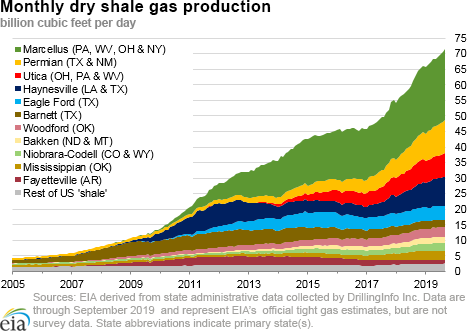In the News:
Natural gas inventories surpass five-year average for the first time in two years
Working natural gas inventories in the Lower 48 states totaled 3,519 billion cubic feet (Bcf) for the week ending October 11, 2019, according to the U.S. Energy Information Administration’s (EIA) Weekly Natural Gas Storage Report (WNGSR). That reporting period was the first week that Lower 48 states’ working gas inventories exceeded the previous five-year average since September 22, 2017, ending a 106-week streak of lower-than-average natural gas inventories. The surplus to the five-year average grew for the second week in row in the subsequent report week. Working gas inventories totaled 3,606 Bcf, or 28 Bcf higher than the five-year average as of October 18. Weekly injections have surpassed the five-year average for the past 10 weeks in a row, exceeding typical weekly injections for that time of year by about 19% on average. Continued strength in natural gas production could result in continued growth in the surplus to the five-year average in coming weeks.
The deficit also decreased because last year’s low inventory levels are now included in the previous five-year average. For this week, the preceding five-year average is about 124 Bcf lower than it was for the same week last year.
The figure shows working gas stocks in the Lower 48 states expressed as the difference from the preceding five-year average. The shaded regions in the figure represent the refill (injection) season, which typically runs from April through October, and the unshaded regions are the withdrawal (heating) season, which runs from November through the following March. The circled numbers represent specific time periods and associated circumstances
-
Injection season, 2017
Working natural gas inventories in the Lower 48 states fell lower than the previous five-year average on September 2017, near the end of the refill season. -
Withdrawal season, Winter 2017–18
Episodes of relatively cold temperatures in the winter of 2017–18—including a bomb cyclone—resulted in record withdrawals from storage, increasing the deficit to the five-year average. -
Injection season, 2018
Several weeks of sustained colder-than-normal temperatures at the beginning of the refill season resulted in continued withdrawals from storage, increasing the deficit to the five-year average. The summer months experienced persistent warmer-than-normal temperatures, increasing electricity demand for natural gas and slowing natural gas storage injection activity. -
Withdrawal season, Winter 2018–19
By November 30, 2018, the deficit to the five-year average had grown to 725 Bcf. Inventories in that week were 20% lower than the previous five-year average for that time of year. Working gas stocks made some modest gains against the five-year average during the 2018–19 winter season, and gains in natural gas production more than offset increased natural gas consumption. -
Injection season, 2019
Throughout the 2019 refill season, record levels of U.S. natural gas production led to relatively high injections of natural gas into storage and reduced the deficit to the previous five-year average.
Overview:
(For the week ending Wednesday, October 23, 2019)
- Natural gas spot price movements were mixed this report week (Wednesday, October 16 to Wednesday, October 23). Henry Hub spot prices rose from $2.25 per million British thermal units (MMBtu) last Wednesday to $2.28/MMBtu yesterday.
- At the New York Mercantile Exchange (Nymex), the price of the November 2019 contract decreased 2¢, from $2.303/MMBtu last Wednesday to $2.282/MMBtu yesterday. The price of the 12-month strip averaging November 2019 through October 2020 futures contracts declined 3¢/MMBtu to $2.348/MMBtu.
- Net injections to working gas totaled 87 billion cubic feet (Bcf) for the week ending October 18. Working natural gas stocks are 3,606 Bcf, which is 17% more than the year-ago level and 1% more than the five-year (2014–18) average for this week.
- The natural gas plant liquids composite price at Mont Belvieu, Texas, fell by 8¢/MMBtu, averaging $5.20/MMBtu for the week ending October 23. The price of ethane, propane, and natural gasoline fell by 4%, 2%, and 1% respectively. The price of butane and isobutane remained flat week over week.
- According to Baker Hughes, for the week ending Tuesday, October 15, the natural gas rig count decreased by 6 to 137. The number of oil-directed rigs rose by 1 to 713. The total rig count decreased by 5, and it now stands at 851.
Prices/Supply/Demand:
Prices rise at major hubs. This report week (Wednesday, October 16 to Wednesday, October 23), Henry Hub spot prices rose 3¢ from $2.25/MMBtu last Wednesday to a high of $2.28/MMBtu yesterday. Temperatures across the Lower 48 states were generally close to normal. At the Chicago Citygate, prices increased 18¢ from $2.11/MMBtu last Wednesday to a high of $2.29/MMBtu yesterday.
California prices are mixed as PG&E implements power shutoffs in Northern California. Prices at Pacific Gas and Electric (PG&E) Citygate in Northern California fell 9¢, down from a high of $3.25/MMBtu last Wednesday to $3.16/MMBtu yesterday. Prices traded within a relatively narrow range throughout the week, and PG&E announced yesterday that it will again shutoff power in certain counties because of high winds and wildfire risk. These shutoffs will affect approximately 178,000 electric and natural gas customers. Prices in Southern California at SoCal Citygate increased 13¢ from $3.27/MMBtu last Wednesday to $3.40/MMBtu yesterday.
Northeast prices are down. Temperatures in the Northeast were seasonal, averaging 50 degrees Fahrenheit (°F), which is close to normal for this time of year. At the Algonquin Citygate, which serves Boston-area consumers, prices went down 7¢ from $2.03/MMBtu last Wednesday to $1.96/MMBtu yesterday after reaching a low of $1.66/MMBtu on Friday. At the Transcontinental Pipeline Zone 6 trading point for New York City, prices decreased 9¢ from $2.04/MMBtu last Wednesday to $1.95/MMBtu yesterday after reaching a low of $1.75/MMBtu on Friday.
Tennessee Zone 4 Marcellus spot prices decreased 13¢ from $1.87/MMBtu last Wednesday to $1.74/MMBtu yesterday. Prices at Dominion South in southwest Pennsylvania rose 3¢ from $1.82/MMBtu last Wednesday to $1.85/MMBtu yesterday.
Permian Basin price discount to the Henry Hub widens as prices fall sharply. Prices at the Waha Hub in West Texas, which is located near Permian Basin production activities, averaged a high of $1.35/MMBtu last Wednesday, 90¢/MMBtu lower than Henry Hub prices. Yesterday, prices at the Waha Hub averaged $0.08/MMBtu, $2.20/MMBtu lower than Henry Hub prices. Prices faced downward pressure as pipelines providing takeaway capacity out of the Permian Basin―El Paso Natural Gas and Transwestern―placed operational constraints on volumes as a result of maintenance.
Supply rises as production growth continues. According to data from IHS Markit, the average total supply of natural gas rose by 1% compared with the previous report week. Dry natural gas production grew by 1% compared with the previous report week. Average net imports from Canada decreased by 3% from last week.
Demand rises in most end-use sectors. Total U.S. consumption of natural gas rose by 2% compared with the previous report week, according to data from IHS Markit. Natural gas consumed for power generation climbed by 2% week over week. Industrial sector consumption decreased by 1% week over week. In the residential and commercial sectors, consumption increased by 6%. Natural gas exports to Mexico decreased 2%.
U.S. LNG exports increase over week. Eleven liquefied natural gas (LNG) vessels (seven from Sabine Pass, one from Cove Point, two from Corpus Christi, and one from Cameron LNG export terminals) with a combined LNG-carrying capacity of 41 Bcf departed the United States between October 17 and October 23, according to shipping data compiled by Bloomberg. Three vessels were loading on Wednesday (one at each terminal: Sabine Pass, Corpus Christi, and Cameron LNG).
Storage:
Net injections into storage totaled 87 Bcf for the week ending October 18, compared with the five-year (2014–18) average net injections of 73 Bcf and last year's net injections of 62 Bcf during the same week. Working gas stocks totaled 3,606 Bcf, which is 28 Bcf more than the five-year average and 519 Bcf more than last year at this time.
According to The Desk survey of natural gas analysts, estimates of the weekly net change from working natural gas stocks ranged from net injections of 75 Bcf to 95 Bcf, with a median estimate of 88 Bcf.
The average rate of net injections into storage is 27% higher than the five-year average so far in the refill season (April through October). If the rate of injections into storage matched the five-year average of 8.8 Bcf/d for the remainder of the refill season, total inventories would be 3,720 Bcf on October 31, which is 28 Bcf higher than the five-year average of 3,692 Bcf for that time of year.
More storage data and analysis can be found on the Natural Gas Storage Dashboard and the Weekly Natural Gas Storage Report.
See also:
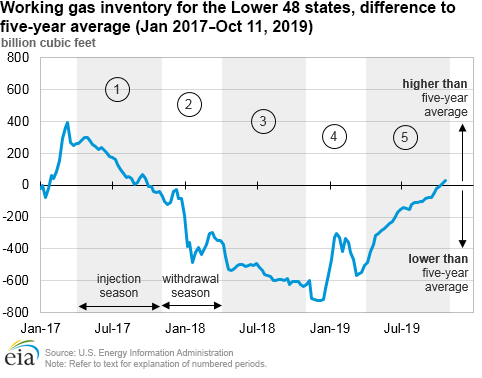
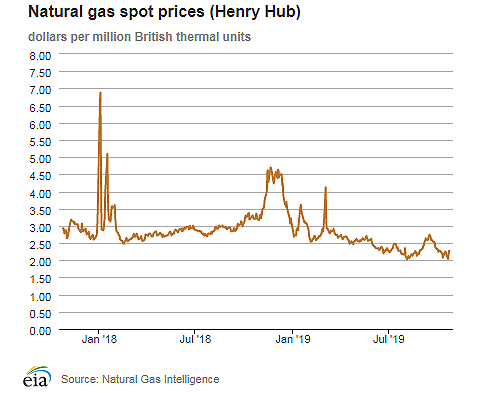
| Spot Prices ($/MMBtu) | Thu, 17-Oct |
Fri, 18-Oct |
Mon, 21-Oct |
Tue, 22-Oct |
Wed, 23-Oct |
|---|---|---|---|---|---|
| Henry Hub |
2.23 |
2.14 |
2.04 |
2.20 |
2.28 |
| New York |
2.02 |
1.75 |
1.89 |
2.11 |
1.95 |
| Chicago |
1.97 |
1.74 |
1.96 |
2.10 |
2.29 |
| Cal. Comp. Avg.* |
2.49 |
2.33 |
2.66 |
2.66 |
2.57 |
| Futures ($/MMBtu) | |||||
| November contract | 2.318 |
2.320 |
2.238 |
2.272 |
2.282 |
| December contract |
2.516 |
2.517 |
2.441 |
2.449 |
2.427 |
| *Avg. of NGI's reported prices for: Malin, PG&E Citygate, and Southern California Border Avg. | |||||
| Source: NGI's Daily Gas Price Index | |||||
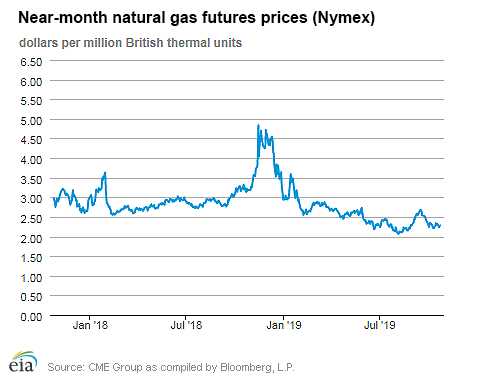
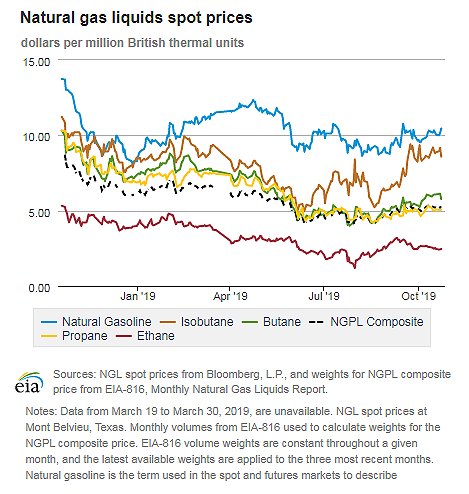
| U.S. natural gas supply - Gas Week: (10/17/19 - 10/23/19) | |||
|---|---|---|---|
Average daily values (Bcf/d): |
|||
this week |
last week |
last year |
|
| Marketed production | 107.5 |
106.8 |
98.4 |
| Dry production | 94.8 |
94.2 |
86.8 |
| Net Canada imports | 4.1 |
4.2 |
4.6 |
| LNG pipeline deliveries | 0.1 |
0.1 |
0.1 |
| Total supply | 99.0 |
98.5 |
91.4 |
|
Source: IHS Markit | |||
| U.S. natural gas consumption - Gas Week: (10/17/19 - 10/23/19) | |||
|---|---|---|---|
Average daily values (Bcf/d): |
|||
this week |
last week |
last year |
|
| U.S. consumption | 64.4 |
63.1 |
66.4 |
| Power | 30.6 |
29.9 |
27.3 |
| Industrial | 20.4 |
20.6 |
21.6 |
| Residential/commercial | 13.3 |
12.6 |
17.6 |
| Mexico exports | 5.3 |
5.4 |
4.9 |
| Pipeline fuel use/losses | 6.4 |
6.4 |
6.1 |
| LNG pipeline receipts | 6.9 |
6.5 |
3.6 |
| Total demand | 82.9 |
81.4 |
81.0 |
|
Source: IHS Markit | |||
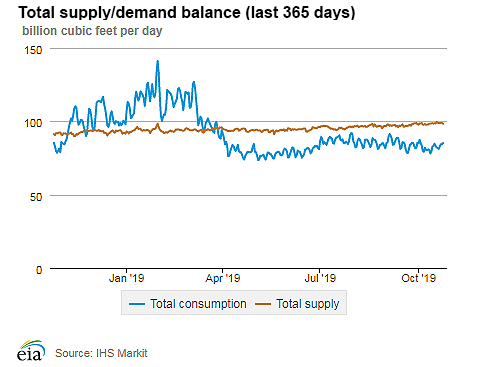
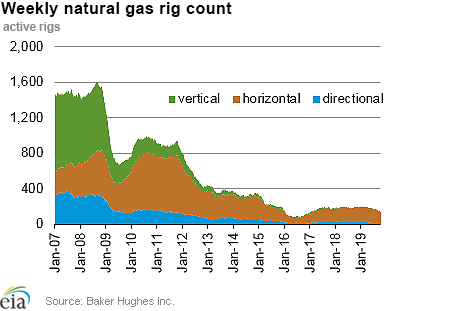
| Rigs | |||
|---|---|---|---|
Tue, October 15, 2019 |
Change from |
||
last week |
last year |
||
| Oil rigs | 713 |
0.1% |
-18.3% |
| Natural gas rigs | 137 |
-4.2% |
-29.4% |
| Note: Excludes any miscellaneous rigs | |||
| Rig numbers by type | |||
|---|---|---|---|
Tue, October 15, 2019 |
Change from |
||
last week |
last year |
||
| Vertical | 0 |
0.0% |
0.0% |
| Horizontal | 11 |
0.0% |
-64.5% |
| Directional | 55 |
0.0% |
-23.6% |
| Source: Baker Hughes Inc. | |||
| Working gas in underground storage | ||||
|---|---|---|---|---|
Stocks billion cubic feet (Bcf) |
||||
| Region | 2019-10-18 |
2019-10-11 |
change |
|
| East | 898 |
880 |
18 |
|
| Midwest | 1,069 |
1,044 |
25 |
|
| Mountain | 208 |
205 |
3 |
|
| Pacific | 297 |
296 |
1 |
|
| South Central | 1,134 |
1,093 |
41 |
|
| Total | 3,606 |
3,519 |
87 |
|
|
Source: Form EIA-912, Weekly Underground Natural Gas Storage Report | ||||
| Working gas in underground storage | |||||
|---|---|---|---|---|---|
Historical comparisons |
|||||
Year ago (10/18/18) |
5-year average (2014-2018) |
||||
| Region | Stocks (Bcf) |
% change |
Stocks (Bcf) |
% change |
|
| East | 823 |
9.1 |
886 |
1.4 |
|
| Midwest | 930 |
14.9 |
1,034 |
3.4 |
|
| Mountain | 177 |
17.5 |
209 |
-0.5 |
|
| Pacific | 262 |
13.4 |
322 |
-7.8 |
|
| South Central | 893 |
27.0 |
1,129 |
0.4 |
|
| Total | 3,087 |
16.8 |
3,578 |
0.8 |
|
| Source: Form EIA-912, Weekly Underground Natural Gas Storage Report | |||||
| Temperature – heating & cooling degree days (week ending Oct 17) | ||||||||
|---|---|---|---|---|---|---|---|---|
HDD deviation from: |
CDD deviation from: |
|||||||
| Region | HDD Current |
normal |
last year |
CDD Current |
normal |
last year |
||
| New England | 87 |
-10 |
-2 |
0 |
0 |
-3 |
||
| Middle Atlantic | 73 |
-12 |
-5 |
0 |
-1 |
-5 |
||
| E N Central | 110 |
19 |
-25 |
0 |
-2 |
0 |
||
| W N Central | 137 |
49 |
-23 |
0 |
-2 |
0 |
||
| South Atlantic | 36 |
-11 |
6 |
34 |
6 |
-13 |
||
| E S Central | 51 |
6 |
5 |
8 |
-4 |
-3 |
||
| W S Central | 31 |
15 |
-11 |
30 |
-1 |
5 |
||
| Mountain | 98 |
12 |
-33 |
12 |
-1 |
8 |
||
| Pacific | 26 |
-6 |
1 |
1 |
-8 |
1 |
||
| United States | 72 |
7 |
-11 |
11 |
-2 |
-2 |
||
|
Note: HDD = heating degree day; CDD = cooling degree day Source: National Oceanic and Atmospheric Administration | ||||||||
Average temperature (°F)
7-day mean ending Oct 17, 2019
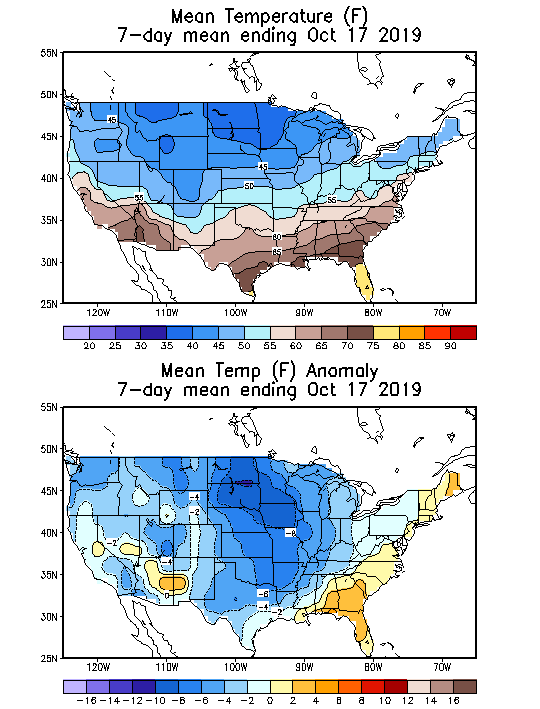
Source: National Oceanic and Atmospheric Administration
Deviation between average and normal (°F)
7-day mean ending Oct 17, 2019

Source: National Oceanic and Atmospheric Administration

